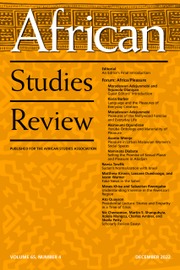In Mediating Violence from Africa: Francophone Literature, Film, and Testimony after the Cold War, George S. MacLeod offers a critical and thought-provoking examination of how contemporary francophone African writers and filmmakers represent political violence. Through four carefully constructed chapters, MacLeod analyzes the ethical and representational complexities surrounding key icons such as child soldiers, Islamist terrorists, genocide survivors, and celebrity humanitarianism. He provides a rigorous and self-reflective account of the “double-bind” that African cultural producers face leveraging globally recognizable symbols to capture attention while risking the perpetuation of harmful stereotypes. From the outset, MacLeod acknowledges his position as a Western scholar addressing African violence. This self-awareness, reminiscent of ethical critiques in postcolonial studies, sets the tone for his analysis of epistemic challenges embedded in Western portrayals of African suffering. At the core of the book lies the concept of cultural and rhetorical mediation, where African artists must navigate between local realities and global perceptions of violence. MacLeod’s work stands out for its theoretical ambition and ability to highlight the hybridity and ambiguity in African literary and cinematic narratives.
In Chapter One, “Using Child Soldiers,” MacLeod examines Amadou Kourouma’s Allah n’est pas obligé and Emmanuel Dongala’s Johnny Chien Méchant. He interrogates the child soldier figure as a political construct that gained prominence in post-Cold War Western humanitarian discourse. Through close readings, he demonstrates how these texts resist reductive stereotypes, exposing the systemic violence that produces such figures and critiquing their exploitation for Western agendas. Chapter Two, “Filming Terroriste, Filming Timbuktu,” shifts to francophone African cinema, analyzing Lemine Ould Mohamed Salem’s Salafistes and Abderrahmane Sissako’s Timbuktu. Here, MacLeod critically examines how filmmakers challenge the global iconography of the Islamist terrorist. While Salem’s documentary risks reinforcing jihadist propaganda, Sissako’s Timbuktu offers a more subversive critique, dismantling jihadist ideologies and humanizing local victims. MacLeod’s discussion demonstrates the power of cinema to challenge dominant narratives without amplifying harmful rhetoric.
In Chapter Three, “Rwanda’s Tutsi Survivors,” MacLeod critiques the inspirational survivor trope that emerged after the 1994 Tutsi genocide. He explores how works like Immaculée Ilibagiza’s Left to Tell have been co-opted into Western frameworks of personal growth and resilience. By juxtaposing Ilibagiza’s memoir with alternative accounts, such as Esther Mujawayo’s SurVivantes, MacLeod highlights the importance of more inclusive and socially engaged narratives that resist symbolic violence and honor the diversity of survivor experiences.
Chapter Four, “The Celebrity Humanitarian Ally,” focuses on the phenomenon of celebrity humanitarianism and its parallels in the francophone literary field. MacLeod critiques figures like Bono, Bob Geldof, and George Clooney, as well as celebrated authors like Alain Mabanckou, for engaging in self-promotional practices that overshadow local voices. This chapter culminates in a compelling discussion of Venuste Kayimahe’s memoir, where MacLeod emphasizes the need for scholarly allyship to center marginalized voices rather than perpetuating hierarchies of visibility.
Throughout the book, MacLeod’s meticulous analysis is supported by rich theoretical frameworks drawn from postcolonial and media studies. His discussion of the “double-bind” offers a valuable lens for understanding the ethical dilemmas African artists face when navigating global platforms. MacLeod’s self-critical reflection, particularly in the conclusion where he confronts his own positionality, adds depth to the book’s ethical engagement with histories of violence and representation. Inspired by Raoul Peck’s documentary Exterminate All the Brutes, he confronts his family’s participation in systems of oppression, stating that recognizing his inherited privileges left him feeling “physically ill” (152).
In conclusion, MacLeod integrates critical frameworks such as the “double-bind” to explain the tension between gaining global attention and resisting reductive stereotypes. His nuanced application of cultural theories (e.g., Bourdieusian analysis) and postcolonial critiques lends significant depth to the work. The book’s examination of literature, film, and testimony provides a holistic view of how African creators respond to political violence. By moving across media, MacLeod offers diverse case studies that enrich the analysis. MacLeod’s candid acknowledgment of the challenges of representing African violence as a Western scholar demonstrates ethical awareness and strengthens the book’s critical legitimacy. His self-reflection engages readers in a broader conversation on academic complicity and positionality. The book is structured with clear thematic focus per chapter (e.g., child soldiers, Islamist terrorism, Tutsi genocide, celebrity humanitarians). Case studies such as Allah n’est pas obligé, Timbuktu, and survivor narratives provide detailed, grounded analyses that illustrate broader theoretical arguments. By critiquing the celebration of iconic figures and highlighting overlooked narratives (e.g., Venuste Kayimahe’s memoir), MacLeod champions inclusivity and challenges the erasure of local perspectives. The analysis of celebrity figures like George Clooney and Bono critiques the commodification of African suffering and emphasizes the need to decenter Global North perspectives. The incorporation of African intellectual traditions or theorists could deepen the analysis. The focus on a limited set of texts and films, though effective, may not represent the full scope of francophone African cultural production. Expanding the range of examples could enhance the book’s comprehensiveness. Certain arguments, such as the critique of humanitarian discourse and celebrity interventions, are revisited across chapters. This repetition, while reinforcing key points, may reduce the book’s conciseness. The book’s dense theoretical language and academic focus will benefit readers outside scholarly circles or those unfamiliar with postcolonial and media studies as its strengths lie in its theoretical depth, ethical self-reflexivity, and advocacy for marginalized voices. I recommend this book as it is a valuable resource for scholars of postcolonial studies, African literature, and media criticism, providing new frameworks to analyze the complex intersections of violence, representation, and global power dynamics.


